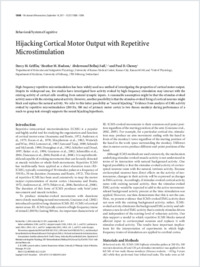Hijacking cortical motor output with repetitive microstimulation
- Griffin, Darcy M. Department of Molecular and Integrative Physiology, University of Kansas Medical Center, Kansas City, USA
- Hudson, Heather M. Department of Molecular and Integrative Physiology, University of Kansas Medical Center, Kansas City, USA
- Belhaj-Saïf, Abderraouf Department of Molecular and Integrative Physiology, University of Kansas Medical Center, Kansas City, USA - Unit of Physiology, Department of Medicine, University of Fribourg, Switzerland
- Cheney, Paul D. Department of Molecular and Integrative Physiology, University of Kansas Medical Center, Kansas City, USA
-
25.07.2011
Published in:
- The Journal of Neuroscience. - 2011, vol. 31, no. 37, p. 13088-13096
English
High-frequency repetitive microstimulation has been widely used as a method of investigating the properties of cortical motor output. Despite its widespread use, few studies have investigated how activity evoked by high-frequency stimulation may interact with the existing activity of cortical cells resulting from natural synaptic inputs. A reasonable assumption might be that the stimulus-evoked activity sums with the existing natural activity. However, another possibility is that the stimulus-evoked firing of cortical neurons might block and replace the natural activity. We refer to this latter possibility as “neural hijacking.” Evidence from analysis of EMG activity evoked by repetitive microstimulation (200 Hz, 500 ms) of primary motor cortex in two rhesus monkeys during performance of a reach-to-grasp task strongly supports the neural hijacking hypothesis.
- Faculty
- Faculté des sciences et de médecine
- Department
- Département de Médecine
- Language
-
- English
- Classification
- Biological sciences
- License
- License undefined
- Identifiers
-
- RERO DOC 28050
- DOI 10.1523/JNEUROSCI.6322-10.2011
- Persistent URL
- https://folia.unifr.ch/unifr/documents/302159
Statistics
Document views: 70
File downloads:
- bel_hcm.pdf: 120
